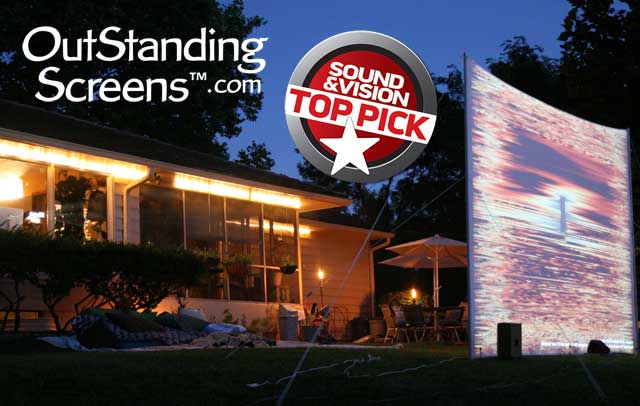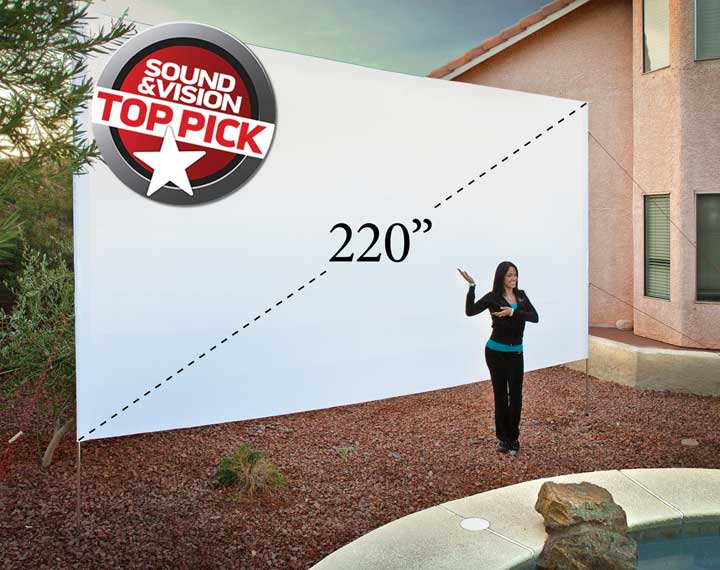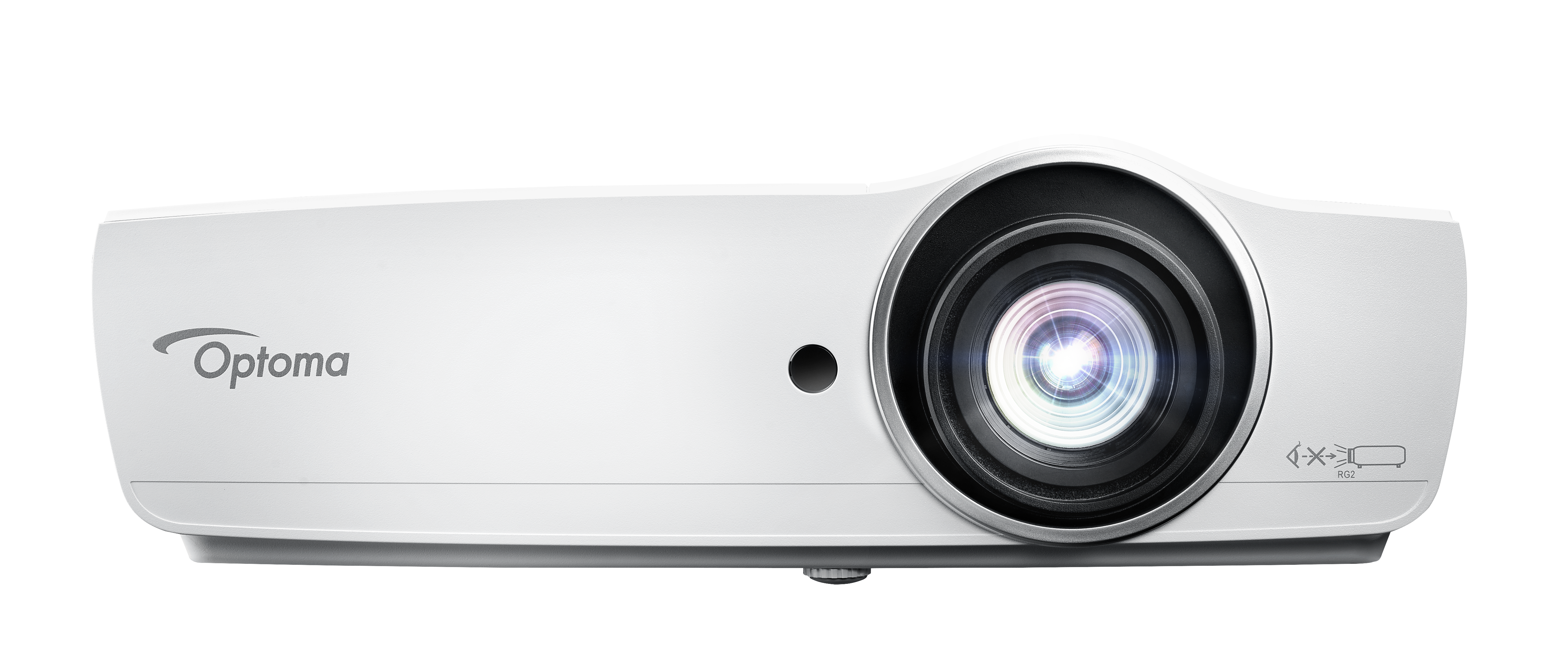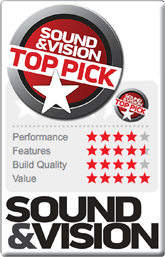Outdoor Theater
Do you want standard resolution video or high-definition? Do you want stereo sound, or surround-sound? There are lots of options that will dictate how you get the most from your equipment. Many components will work, but if you take some time to understand your equipment and especially the types of connections, inputs and outputs that are available, you can vastly improve your experience. Feel free to contact us if you have any questions, we are glad to help!

What do I need to show movies in my backyard?
A Screen: The surface you project on. We recommend one of our OutStandingScreens™.
A Video Projector: This is the device that projects your video source. The projector gets its signal (video-in) from your video player (video-out). If you already own a projector, problem solved. If you are buying a projector there are some things you should consider.
A Video Source: The video player sends video (video-out) to your projector's (video-in). The video player can be a dvd player, computer, video camera, VCR, phone, anything that has an external video port. That video source is fed to your projector using the appropriate cabling.
A Stereo: Your stereo gets its sound (audio-in) from the video player’s (audio-out). Your speakers connect to your stereo.
Choosing a Screen
Some people hang a sheet on the wall and call it good! Others want to step it up a notch or two. Outdoor movie screens run a wide gamut. There are both smaller and larger screens on the market. Some have rigid metal structures, some inflate with one or more fans. Our approach to outdoor movie screens was to keep them as portable, simple, versatile and affordable as possible.

Features to consider:
Diagonal Measurements: Pay attention when you are pricing screens; some sell the measurements of the structure rather than the screen. A screen’s actual size
Choosing a Projector
Any projector can work, but what if you are shopping for something new consider the following. The better the quality of the projector the better the quality of the image on the screen. Just like everything electronic, there are a host of options to choose from. The projector receives a video signal (video-in) from the video player's (video-out) and projects the video on the screen.

Features to consider:
Brightness: Measured in lumens, we have had good luck with projectors putting out 2,000 lumens to our largest screen. We have shown movies through interior windows and porch screens with very acceptable results.
Contrast: The higher the better. More contrast equals
Video Players
The "player" of your movie will likely be a computer, dvd player, Blu-ray, or a video game console. Video can come from phones to blue ray players these days and now you don't even need players in some instances, see below. If you are going the more conventional route, the "video-out" of your movie source connects to the "video-in" of your projector and you now have a picture. In fact, if you can connect it to a TV, then you can connect it to a projector!
For those with Apple TV, Amazon Fire, Google Chromecast, and other HDMI plug-in players, just plug your network device directly into the HDMI port of your projector. Your projector is basically a television, so if you can connect to a television, then you can connect to a projector!
Features to consider:
Video-Out Connections: What connections are available to go out to your projector? Most video players offer multiple connections both in and out. Understand the difference between composite, s-video, and component video signals. Component or HDMI are the current top-of-the-line cabling options for
The Stereo
Doesn’t a big picture deserve a big sound–without driving the neighbors nuts? The sound that you play on your stereo comes from your video source's (audio-out) and has to connect to your sound system's (audio-in). You can choose between a two-speaker stereo configuration, or a five-speaker surround-sound setup. We at OutStandingScreens™ like to use 5.1 surround-sound, sub-woofer optional.
TIP: Watching all-night movies with a few friends? Move the speakers in towards your group. It will sound louder while allowing you to turn down your volume and stay friends with your neighbors.
Features to consider:
Stereo vs surround-sound: Stereo requires two speakers and separates the sound into right and left channels. 5.1 surround-sound uses five channels and means that there are five speakers used, plus one sub-woofer (optional). There is also 7.1 surround-sound, seven speakers and one sub-woofer.
Whatever your choice, bear in mind that
Proper Cabling
Video and audio cables offer varying levels of quality. If your video equipment has more advanced connections like s-video, or especially component quality, then you will really get the best quality from your equipment.
Video Cabling
Video connections are very important to your picture quality. Each subsequent option below carries more information than the one before. More information equals a better picture. It is possible to take a good video option and turn it into a bad one with faulty logic and the right adapters. The order below starts with a simple single RCA cable, then comes s-video, and finally RGB or component offers the best picture quality. You'll notice that
Aspect Ratios
Understanding aspect ratios will explain why you may see black bars around your screen image. If your source video is not in the matching aspect ratio of your screen, you will see a black area at the top and bottom of the screen or at the left side and right side of the screen. There isn't much you can do about the "problem" other than understand why it happens as the "solutions" offer problems themselves. The "solutions" are the reason you see stretched images or cut-off titles. The video is either stretched to fit the aspect ratio, or cut off to fit the aspect ratio. We prefer seeing the full intended viewing area with no stretching or cropping of the image.
Screen proportions or aspect ratio:
Aspect ratios are a way of defining the proportions or shape of a screen. A modern television has 16:9 aspect ratio. A square has the aspect ratio of 1:1. In other words, for every unit one direction there is an equal unit the other direction. For 16:9



